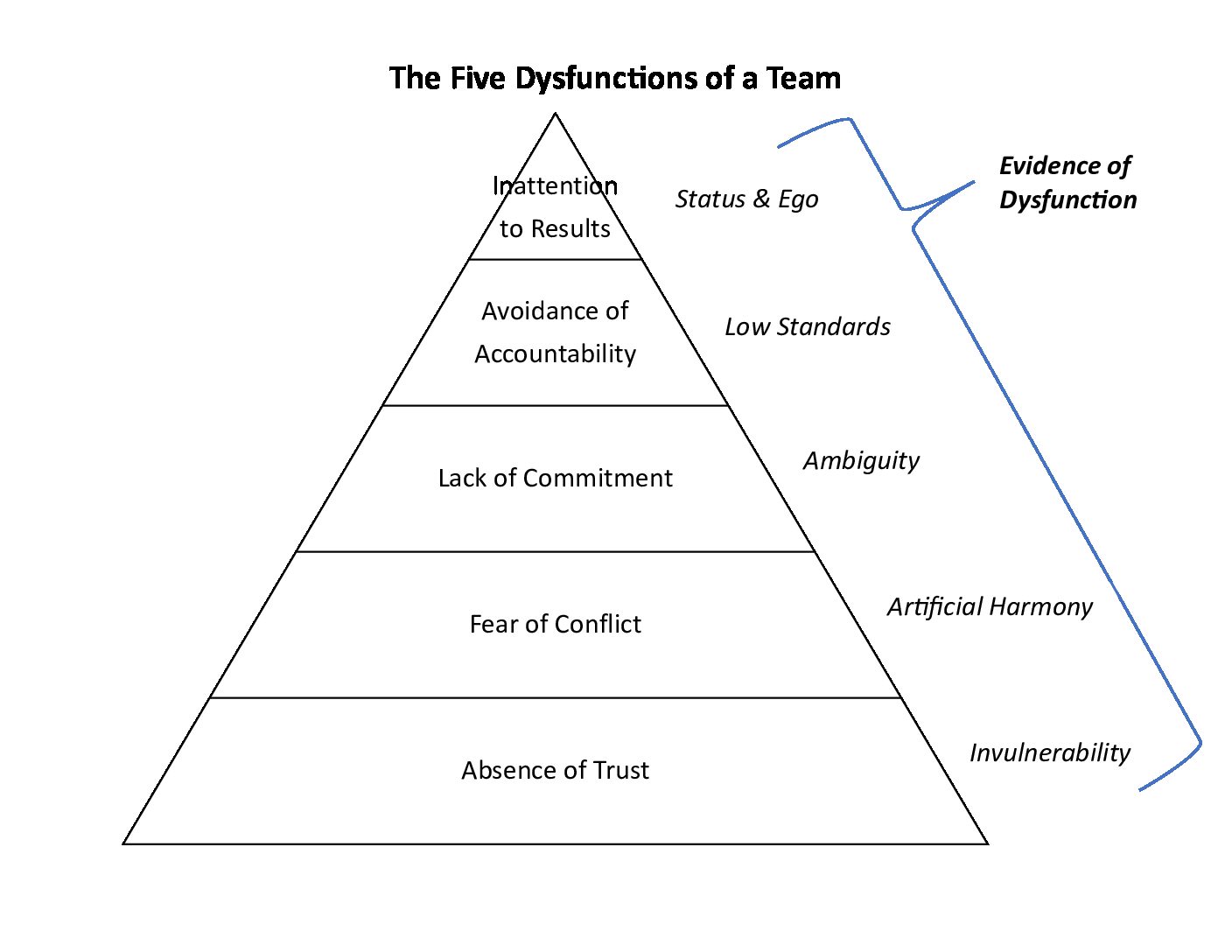Several days ago, I listened to one of The Impact On Leadership (IOS) podcasts with moderator Steve Scherrer interviewing Carthage College President John Swallow. I was intrigued for several reasons. First, we currently employ a talented Carthage intern and are excited about Carthage’s new School of Business and Economics program. Alan and I support the active learning opportunities this program provides students by placing them in the real world of work whenever possible. And second, President Swallow mentioned a book he liked called The Five Dysfunctions of a Team by Patrick Lencioni.
When Swallow detailed what these dysfunctions were, I added this book to the ever-growing stack of “to be read soon” in my office. However, this particular title hooked me, provoking a few bad memories of my own experiences with dysfunctional teams. I was quickly engaged by the fable Lencioni uses to demonstrate the five dysfunctions in action. The story line follows newly hired CEO Kathryn Petersen as she observes meetings for two weeks then schedules an off-site session fraught with dysfunctional behaviors. Less pleasant than the intriguing fable were my own memories of dysfunctional teams and the realization that I contributed to the dysfunction myself. Forty-eight hours later, I finished the book and started this blog – the first of five focused on (you guessed it) Lencioni’s The Five Dysfunctions of a Team.
Lencioni presents these five in pyramid style with Absence of Trust at the base. Why? Because It’s the one to address first if there’s any hope of getting to the next four. The words outside the pyramid represent evidence of the dysfunction at work.
Before examining the Absence of Trust, let’s consider what Lencioni has to say about its presence. It’s “the confidence among team members that their peers’ intentions are good and that there is no reason to be protective or careful around the group.” Trust—the foundation for creating cohesive teams, encouraging innovation, and ultimately achieving organizational goals. In thriving organizations, trust is largely built on integrity, transparency and the belief that everyone has a voice and ideas that have the potential to help the company succeed. Note the focus on company, not the individual’s need for recognition. We often assume this level of trust develops over time as we observe people’s abilities, personalities, and responses to others. But Lencioni warns that trust can erode over time if team members neglect trust-building behaviors.
So, what does the absence of trust in an organization look like? Lencioni sees it as frequently identified by an unwillingness to be vulnerable. People are hesitant to share thoughts, opinions, ideas, concerns, even fears because the situation or the environment doesn’t feel safe to do so. Either the risk to job security or reputation seems too high or the benefit or gain to the individual is too low in comparison. Either way, open communication is compromised and opportunities for improvement and growth are lost.
The Secret to Real Company Growth
The “absence of trust” is manifested by a closing off or invulnerability. In other words, NOT being willing to be vulnerable, to show weaknesses, skill deficiencies, interpersonal shortcomings, mistakes or to make requests for help. Real company growth can happen when people switch their energy from protecting individual egos and reputations to completing projects successfully and working toward achieving company goals.
Healthy teams don’t happen in an unsafe environment where suggestions or questions are met with barely audible sarcasm or rolling eyes. Managers and employees dread attending meetings like this and CEOs are too often baffled when it comes to changing this toxic environment. So, what can CEOs, managers and anyone responsible for facilitating team activity do? Lencioni has these suggestions:
- Ensure that the sharing of vulnerabilities—weaknesses, skill deficiencies, interpersonal shortcomings, mistakes and even requests for help—won’t be used against you. It’s tough to be vulnerable because we’re groomed to compete, to be the best at what we do. And we are often protective of our reputations. An effective team leader seeks to manage these natural instincts for the good of the team. Judgmental statements are an absolute NO! “That is the most ridiculous idea I’ve ever heard,” won’t fly. But a question may work. “How do you see us implementing that idea?”
- Engage team members in icebreakers during an initial session, sharing some information about their personal history – siblings, hometown, unique challenges in childhood, favorite hobbies, first job, worst job. Participants loosen up and even find humor in these shared topics.
- Ask participants for the single most important contribution each has made to the company. If trust is beginning to show, ask for one behavior each could discard for the good of the team. Finally ask each member to share their response to the others’ observations.
- Use a personality profiling tool (like Myers-Briggs, True Colors, DiSC, 16 Personality Factor Questionnaire) so participants are active in determining their own personality types while discovering their peers’. The result? Collaboration comes easier when each person understands how best to relate to fellow team members.
- Conduct an activity to identify strengths and weaknesses in fellow team members without any negative repercussions (compensation or performance evaluation).
- Engage the team in experiential exercises as a group—ropes for instance—but only if activities are layered on more fundamental and relevant processes since these kinds of activities tend to have short-lived impact.
Whatever is done, regular follow-up that’s tied to daily work in the organization sustains developed trust. Lost momentum has the potential to erode any trust that’s gained.
Team leaders should also keep these tips top of mind when working to build trust.
- Demonstrate trust first – be vulnerable; risk losing face in front of the group by acknowledging weaknesses. Be the example.
- Create an environment that approves of people being open and vulnerable; not chastising vulnerability as being weak.
- Be genuine about vulnerabilities; don’t feign them to manipulate emotions of others.
Once a bond of trust develops, conflict (the next level up in the diagram) is handled much better. In fact, expect conflict in the trust-building process as team members become comfortable with one another and disagree or challenge ideas and opinions. But handling conflict is the next blog. Stay tuned.
If you’re having trouble with your team, give us a call. We are here to help!











0 Comments